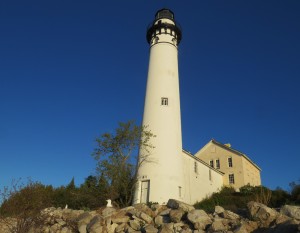By David Fleet
Editor
Leland-For about six weeks Jonathan Schechter’s commute to work each day included 117 steps up to the top of a lighthouse towering more than 100 feet above Lake Michigan.
From May 23 until July 3, Schechter, a Brandon Township resident and on-call firefighter, served as the lighthouse keeper on South Manitou Island. He was one of three individuals selected by the National Park Service for six week-long stints to run the working maritime feature on northeastern Lake Michigan, about 14 miles off the coast of Leland—part of Leelanau County and the Sleeping Bear Dunes National Lakeshore.
“On the lighthouse, you realize you’re just a speck out there,” said Schechter, who also served as keeper in the summer of 2016. “My job as lighthouse keeper was to greet the boats coming to the island each day and take people up in the lighthouse if they wanted to climb up. The visitors are often overwhelmed by the view from the top—the sunsets and rises, it’s just so very blue. People say it’s just like the Mediterranean, I tell them, ‘you mean the Mediterranean looks like Lake Michigan.’”
The small island is about 3 miles by 3 miles, or 5,888 acres, and features Florence Lake along with a system of trails and campsites. The island is accessible by the Manitou Island Transit from Leland that makes the trip over daily in the summer months.
Schechter said that recent massive gale winds pounded the island for more than two days .
“The island lost about six to eight feet of shoreline near the lighthouse,” he said. “While the storms are normal out there this one did extensive damage and threatens the stability of the lighthouse foundation.”
According to the National Park Service, existing shoreline is now approximately 45 feet from the base of the lighthouse and 20 feet from the fog signal building. As a result, the National Park Service is preparing an environmental assessment for shoreline stabilization and rehabilitation at the lighthouse complex. The purpose of this action is to protect the lighthouse complex by stabilizing the shoreline.
“The cost of the project will be in the millions,” said Schechter. “It’s a massive project in some very dynamic environmental conditions. Keep in mind, too, everything has to shipped out from the mainland. It’s a big project.”
The summer weather of 2017 was far more unstable than other years.
“Several times this summer the boats from the mainland stranded campers,” he said. “If the passage is too rough they just don’t risk it. We had at least 40 backpackers spend an extra night out there. Day trips were cancelled, too—they won’t drop you off if they can’t pick you up the same day. People do try to kayak to the island from the mainland, but it’s not recommended. The distance, weather temperature, currents and wind play a huge factor.”
The small island is significant in Michigan history due to a unique natural deep water harbor known as Crescent Bay—the deepest natural harbor between Chicago and Buffalo, NY. So important is the location that in 1838 Congress OK’d $5,000 for the construction of the first lighthouse to help ships navigate the often turbulent waters of the Manitou Passage.
“The island functions well without human interference,” he added. “Despite some impact from humans, the recovery of the Piping Plover, a critically endangered species in the Great Lakes regions, is improving. It’s a great sign.”
In 1871 a second lighthouse was built due to the shipping traffic and the number of wrecks in the area. The 100-foot lighthouse, which according to the Sleeping Bear Dunes National Lakeshore historians is 18 feet in diameter at the base, was in full operation until 1958.
